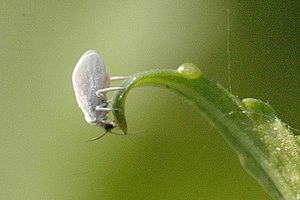Siphoninus phillyreae
| Siphoninus phillyreae | ||||||||||||
|---|---|---|---|---|---|---|---|---|---|---|---|---|

Siphoninus phillyreae |
||||||||||||
| Systematics | ||||||||||||
|
||||||||||||
| Scientific name | ||||||||||||
| Siphoninus phillyreae | ||||||||||||
| ( Haliday , 1835) |
The Siphoninus phillyreae is a moth scale insect from the Aleyrodidae family . It is, together with other species of whitefly , also referred to as whitefly or, grammatically incorrectly, as ash whitefly (translation from English ash whitefly ). Siphoninus phillyreae is seen as a pest when it occurs in large numbers on fruit trees and ornamental trees and is combated by biological measures .
features
Siphoninus phillyreae are 1.5 millimeters long. They have a light beige body and white wings that are 3 millimeters long. When resting, unlike many other species of whitefly, the wings are folded at an angle. The larvae are white to gray in color.
Siphoninus phillyreae secretes a waxy substance from 40 to 50 siphons on the back .
Occurrence
Siphoninus phillyreae was described by Alexander Haliday in 1835 as Aleyrodes phillyreae after a type specimen that had been found in Dublin (Ireland) on a stone linden ( Phillyrea latifolia ) from the olive family . The animals are native to Europe , North Africa , the Middle East , southern Russia , Pakistan and India , but were introduced with plant deliveries to orchards and plantations on other continents such as North America and Australia.
Siphoninus phillyreae occurs on ash trees , but also on apple, pear and quince trees and on citrus trees from April to December. Like all whiteflies, it is fought as a pest. In their autochthonous habitat, the natural enemies are sufficient to reduce the infestation of the plants; in regions where they were introduced and there are no predators, such species were imported for biological control.
Way of life and reproduction
After mating, the females lay 5 or 6 eggs on the underside of the leaves of useful and ornamental plants , including on house walls. Their development cycle is similar to that of the greenhouse moth scale , but they hatch earlier than this and at a temperature between 10 and 30 degrees. The larvae develop into adults within 25 days. As a rule, they move less than an inch away from where the egg is deposited. The fourth larval stage ( pupa ) is immobile.
Harmful effects and pest control
Both the nymphs and the adult whitefly suckle plant juices and thereby damage their host plants. The scale insects secrete honeydew , which promotes mold growth and other fungal diseases. Leaves from plants also fall off, the fruits remain small.
To be particularly effective in the biological control of Siphoninus phillyreae the proving Bow dwarf ladybug , but also other animals such as Acletoxenus formosus from the family of fruit flies or Encarsia TYPES of the superfamily of jewel wasps are on offer.
supporting documents
Individual evidence
- ↑ Tom S. Bellows, Timothy D. Paine, Ken Y. Arakawa, Carol Meisenbacher, Paula Leddy, John N. Kabashima: Biological control sought for ash whitefly. California Agriculture 44, 1, pp. 4-6, 1990 ( full version ).
- ^ Peter S. Gillespie: A new whitefly for NSW - The Ash Whitefly. NSW Agriculture.
literature
- TS Bellows, TW Fisher: Handbook of biological control: principles and applications of biological control. Academic Press Inc., 1999, pp. 441-442, ISBN 0-12257-305-6 .
- Ru Nguyen and Avas B. Harmon: Ash Whitefly, Siphoninus phillirea (Haliday) (Homoptera: Aleyrodidae: Aleyrodinae). Florida Dept. of Agricultural and Consumer Services, Entomology Circular No. 337, 1990 ( full text ; PDF, English; 329 kB).